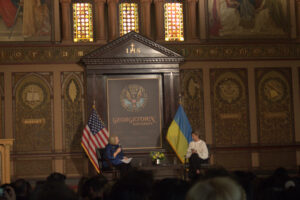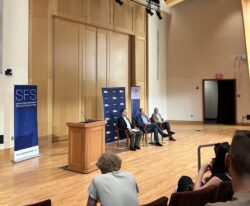Feb. 24 marked the one-year anniversary of Russia’s full-scale invasion of Ukraine. In commemoration, members of the Georgetown University Ukrainian Society (GUUS), founded by students Andrii Sendzuik (MSB ’24) and Sofia Sulek (SFS ’23) last year, organized and attended a weekend of events to draw attention to the current situation in Ukraine.
The events began on Feb. 24 with an exhibition titled “One Year Later: Hoyas in Solidarity with Ukraine.” The day was especially important to Georgetown’s 12 Ukrainian students, who reflected on how much their lives have changed since the invasion.
Standing on a small platform in the bright ICC galleria, Ukrainian students took turns speaking to an audience of nearly 200 guests.
In her short speech, graduate student Juliana Kogan (MASIA ’23) remembered the moment Russia invaded Ukraine. At the time of the invasion, Kogan was in the U.S.
“I felt helpless because they were there and I was here and there was nothing I could do,” Kogan said. “I refuse to let this war be our legacy.”
In his speech, Kyryl Myronenko (SFS ’26) tried to focus on his emotions and the lessons that can be learned from the war, rather than “simply saying, ‘Oh my goodness, this is bad.’”
“There’s a lot of messages we, as Ukrainians, are obliged to send to the Georgetown community, where there’s so much emphasis on the education of future world leaders,” Myronenko said. “I felt very grateful that I was given the opportunity to speak and share thoughts and emotions.”
“I felt very comfortable because I was just looking into everyone’s eyes and I felt so much compassion for my country and my people,” Myronenko said.
Posters to the left of the platform told the stories of young Ukrainian students, many of whom had sacrificed their education to defend Ukraine, and had been killed by the Russian invasions. The posters, which were presented at events in multiple countries, displayed these students’ unissued diplomas.
On the evening of Feb. 24, Ukrainian students and allies met at Georgetown’s front gates and walked to the Russian embassy, where local Ukrainian leaders held a protest and vigil. Demonstrators chanted phrases, ranging from “Slava Ukraini! Heroyam Slava!” (Glory to Ukraine! Glory to heroes!) to “Putin khuylo!” (Putin is a dickhead!), heard speeches from prominent local organizers, and sang Ukrainian songs. Some members of the crowd placed toys by the foot of the Russian embassy gate to honor the children who have been killed in the war.
Protesters projected a Ukrainian flag onto the embassy’s imposing white walls. In an attempt to drown out the yellow and blue lights, the embassy responded by using floodlights to spell “Z V Z” on the building. These symbols of Russian aggression have often been compared to the Nazi swastika.
Myronenko said he had seen this before when GUUS attended previous protests at the Russian embassy. “They always respond in such a filthy way,” Myronenko said.
The morning of Feb. 25, about a dozen students headed to the Lincoln Memorial where they joined hundreds of Ukranians and allies in a rally held by the D.C. Ukrainian community.
“There were so many good speakers,” Myronenko said. “There was also a Ukrainian choir. Some Ukrainian kids going to the local school here started reading Ukrainian poems, which was very touching. Then we started marching—the entire column of people—to the White House and then to the residency of the Russian Ambassador.”
For the final event of the weekend on Feb. 26, the Ukrainian society held a movie screening of “A House Made of Splinters” in the ICC auditorium. The documentary finished filming just before Russia’s formal invasion and focuses on children who have been removed from their houses due to violence or abuse in Eastern Ukraine. The filmmakers had reached out to GUUS to see if the club wanted to hold a pre-release screening.
“It was very honorable that they reached out to us saying we’d like you to help us,”Myronenko said. “That was a very great moment for us as an organization and the Ukrainian community.”
After Russia’s invasion last year, Myronenko left his home in Cherkasy and his parents. “I was in seven different countries and then got to the United States,” he said. “I’ve been all around the world, seeing different Ukrainian people who’ve had to become refugees for various reasons.”
Myronenko was able to return home during the winter and spring breaks. “Every time I’m at home, it’s very different,” Myronenko said. “During spring and winter break, no electricity, no power for 10 hours a day… I try to talk with my parents every single day. I try to know everything and feel what they are experiencing. But of course I can never fully grasp because you don’t realize it until you’re there.”
“When I came home for that first day of winter break, I had this moment of realization,” he added. “It’s supposed to be Christmas time. Everything’s supposed to be faster. But no, it was absolutely not. Just overwhelming darkness.”
GUUS provides opportunities to students to learn about and take action against the war in addition to giving Ukrainian students and allies a space to celebrate and educate themselves about Ukrainian culture.
“I feel that some people don’t realize how distinctly unique our culture, language, and traditions are. Our nation has a millennia-long history, and so does our culture,” Myronenko said. “And definitely the way to experience this all is to join Ukrainian Society events.”





